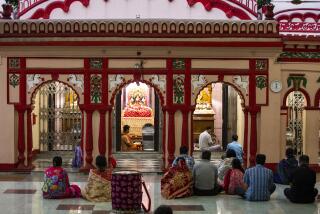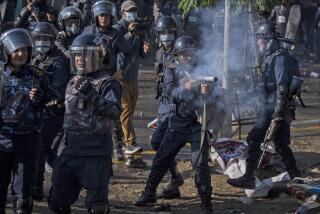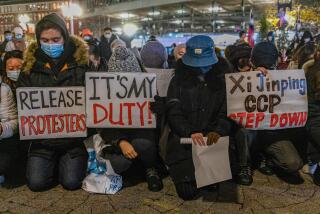Tales of horror from Tibet
- Share via
BEIJING — On a cloudless day near the top of the world, Swiss tourist Claude Balsiger had just finished a late-morning cup of tea and stepped out onto the streets of Tibet’s capital. Buddhist monks had been marching against Chinese rule all week, but today seemed calmer.
Suddenly, Tibetan youths started hurling paving stones at police, who tried to protect themselves with their riot shields.
Over the next few hours, the odor of tear gas and fires replaced the scent of incense wafting from backpacker cafes. The intense Himalayan light was blacked out by smoke. And in the days that followed, violence would spread beyond Lhasa to ethnic Tibetan villages deep inside China and to Chinese embassies worldwide.
China has barred Western journalists from entering Tibet and ethnic Tibetan areas. But interviews with foreign witnesses and Chinese residents, as well as blog postings by Tibetans too frightened to be interviewed, show that during three crucial hours on March 14, woefully unprepared police fled, allowing rioters to burn and smash much of Lhasa’s commercial center.
Tibetans randomly beat and killed Chinese solely on the basis of their ethnicity: a young motorcyclist bludgeoned in the head with paving stones and probably killed; a teenage boy in school uniform being dragged by a mob. When authorities did regroup, paramilitary troops fired live ammunition into the crowds. Witnesses did not see protesters armed with anything other than stones, bottles of gasoline or a few traditional Tibetan knives.
Despite a massive deployment of Chinese forces, the protests show no signs of abating. In New Delhi on Friday, Tibetan exiles stormed the Chinese Embassy. And China posted a “most wanted” list of 21 alleged rioters, featuring grainy photographs taken from video shot by a hidden camera.
The death toll of Tibetans had risen to 99 as of Friday, with a 16-year-old girl being shot by police in China’s Sichuan County, the Tibetan government in exile said.
Chinese authorities say 19 Chinese have been killed in Lhasa: one police officer and the rest civilians.
Since their homeland was invaded by Chinese communists in 1951, Tibetans have risen up periodically against Beijing’s rule. Led by the Dalai Lama, a Buddhist monk and Nobel Peace Prize laureate, their movement has been largely nonviolent. There hadn’t been a substantial uprising in Lhasa since the late 1980s, giving the city a reputation as a laid-back Shangri-La.
“Tibetans usually are so calm and friendly, but suddenly they were insane,” said Balsiger, 25, a teacher. “They were howling like wolves. . . . It was so brutal, so violent.”
March 10, Monday
Everybody is girded for demonstrations today. It is the 49th anniversary of the failed Tibetan revolt in which their leader, the Dalai Lama, fled into exile in India. This year the protests are expected to be bigger because activists hope to use the upcoming Summer Olympics in Beijing to press their case.
Tibetan demonstrations are well-choreographed: Monks, who ran Tibet in pre-communist times, usually take the lead while laypeople try to protect them.
At 6 p.m., a parade of about 300 red-robed monks leaves the 15th century Drepung Monastery, five miles west of downtown Lhasa. Blocked by police from reaching the city, the monks sit for several hours at a checkpoint before dispersing.
At dusk, students and monks stage a second demonstration in the center of Lhasa, making a circle around Barkhor Square and joining hands. The square is filled with uniformed and plainclothes security officials. A young Dutch couple watch police take away six or seven demonstrators.
“Everybody is afraid to speak,” the Dutch tourists, Steve Dubois and Ulrike Lakiere, write later on a blog. “Even us, free-born people, not for our sake, but for that of the Tibetans who can get in trouble just by speaking with us.”
Balsiger recalls meeting a young Tibetan brother and sister at a cafe. Although he and they have no common language, he understands that they live in fear of Chinese undercover police. They nervously show him that they wear images of the Dalai Lama, which are banned, on strings around their necks, hidden under their clothes.
March 11, Tuesday
Nine monks emerge from the Sera Monastery north of Lhasa carrying a banned Tibetan flag and are almost immediately dragged away by police.
Several hundred more monks come out to demand their release. The paramilitary Chinese People’s Liberation Army police disperses the crowd with tear gas.
March 12, Wednesday
Many stores in Lhasa are closed. Tsering Woeser, a Tibetan poet who writes a blog, says two monks at Drepung Monastery slit their wrists in suicide attempts, and monks at Sera Monastery start a hunger strike. Water supplies are cut to many of the monasteries.
A foreign tourist wanders into Sera Monastery at 3 p.m., just as hundreds of monks are rushing out, their hands in the air and in obvious distress. Police surround them.
“They were grabbing monks, kicking and beating them. One monk was kicked in the stomach right in front of us and then beaten on the ground,” the tourist later tells BBC.
Paramilitary forces block roads leading out of the remote Ganden Monastery. The Chutsang Nunnery is also surrounded.
March 13, Thursday
Roadblocks are in place around Lhasa. Thousands of paramilitary forces are reported to be searching houses for photographs of the Dalai Lama.
March 14, Friday
Stores reopen. The trouble appears to have passed. But about 11:30 a.m., as the morning prayer finishes at Ramoche Temple, a small Buddhist shrine up a pedestrian street from the main square, police block monks from marching. This time, onlookers start throwing stones at police.
Trucks carrying reinforcements speed down Beijing East Street, the main drag. As soon as police climb out, the stones start flying again. About 20 protesters in their teens and 20s are cheered on by several hundred older Tibetans.
Rioters use their bare hands to pry paving stones loose and hurl them with such ferocity that they crack police shields. The police officers, some of them teenagers themselves, hurry into an alley for cover. The enraged crowd begins to vent its anger on ethnic Chinese passersby.
“At first it was sort of a game. You throw the rocks and you run away,” Susan Witmore, a Canadian business consultant who had given herself a trip to Tibet as a 60th birthday present, later recalls. “But then the scene turned incredibly ugly.”
A young Chinese motorcyclist is struck by stones. Witmore utters a silent scream to the man, “Keep moving!” but the motorcyclist stops, as if to reason with the mob. Soon his flashy gold helmet is off and the mob is pounding his head with stones and pipes. Witmore, who was watching from the lobby of her hotel, retreats into the courtyard in horror. Other tourists say later that they believe the man was killed.
Balsiger sees the crowd pull a Chinese-looking man off a bicycle. A teenage boy is bludgeoned on the head, but as he staggers, bleeding on the pavement, barely conscious, a tall foreign man steps in and pulls him to safety.
Police flee, and by early afternoon the mobs have the run of the city. They go after Chinese shopkeepers, who these days dominate the commercial life of Lhasa.
“They thought we Han Chinese people were coming to steal from their rice bowls,” says the manager of Top of the World Hotel on Ramoche Street, near the temple. She cowers in her courtyard as the crowd sets fire to many of her neighbors’ businesses.
The mob is more interested in destroying than looting. Witnesses see cellphones, bicycles, clothing, food and furniture smashed along Beijing East Street. Cars are overturned and set on fire, often topped with burning Chinese flags.
Riots spread to the Muslim quarter, targeting the Hui, Chinese Muslims who have been opening businesses in Tibet. Rioters smash holes through metal shop gates and pour in gasoline. A Muslim family later describes to Chinese journalists how they hid in a bathroom as flames spread around them. The main gate of the mosque is set on fire, but the mob doesn’t get inside.
It is not until 4 p.m. that Chinese authorities venture back into the center of Lhasa. What happens next is unclear, because by this time the city is under a strict curfew. According to Tibetan sources, the Public Security Bureau lifts an order restricting the use of live ammunition by the paramilitary forces.
Tibetans say many people are killed in front of the main temple, the Jokhang, and that families come to collect the bodies late at night, offering prayers and strewing traditional white prayer scarves.
“Many of those killed were young Tibetans, both boys and girls,” a rioter tells Radio Free Asia. “Those who are dead sacrificed their lives for 6 million Tibetans. My disappointment is that we were not armed.”
Amid the raging violence, some Tibetans do step in to help the beleaguered ethnic Chinese.
A 24-year-old Chinese assistant at an optometry shop recalls how a teenage neighbor escorted her home, only to be chastised by a Tibetan security guard who asked, “How can you come back with a Han Chinese?”
The Tibetan girl “was horrified,” recalled her Chinese friend. “In her eyes were confusion, perplexion, sorrow and mostly astonishment.”
March 15, Saturday
Overnight, soldiers move into the center of Lhasa. By the end of the day, they have the city under control. But protests break out elsewhere. At Labrang Monastery in Xiahe, 750 miles to the northeast, more than 1,000 Tibetans march against the Chinese.
March 16, Sunday
Protesters carrying photos of the Dalai Lama and the Tibetan flag stage protests in Sichuan, Gansu and Qinghai provinces. In remote Aba County in Sichuan, Tibetans attack a police station and set fire to a market, firetrucks and police cars. Police reportedly fire into the crowd, killing at least eight.
March 17, Monday
Protesters try to storm Chinese embassies and consulates around the world.
“Chinese people have to realize we can’t bear any more,” says Tenzin Lama, 25, a Tibetan student demonstrating in London. “We will give up our lives to fight for our beliefs. Tibetans won’t stop.”
--
--
Jia Han, Cathy Gao and Eliot Gao of The Times’ Beijing Bureau contributed to this report.
More to Read
Sign up for Essential California
The most important California stories and recommendations in your inbox every morning.
You may occasionally receive promotional content from the Los Angeles Times.










